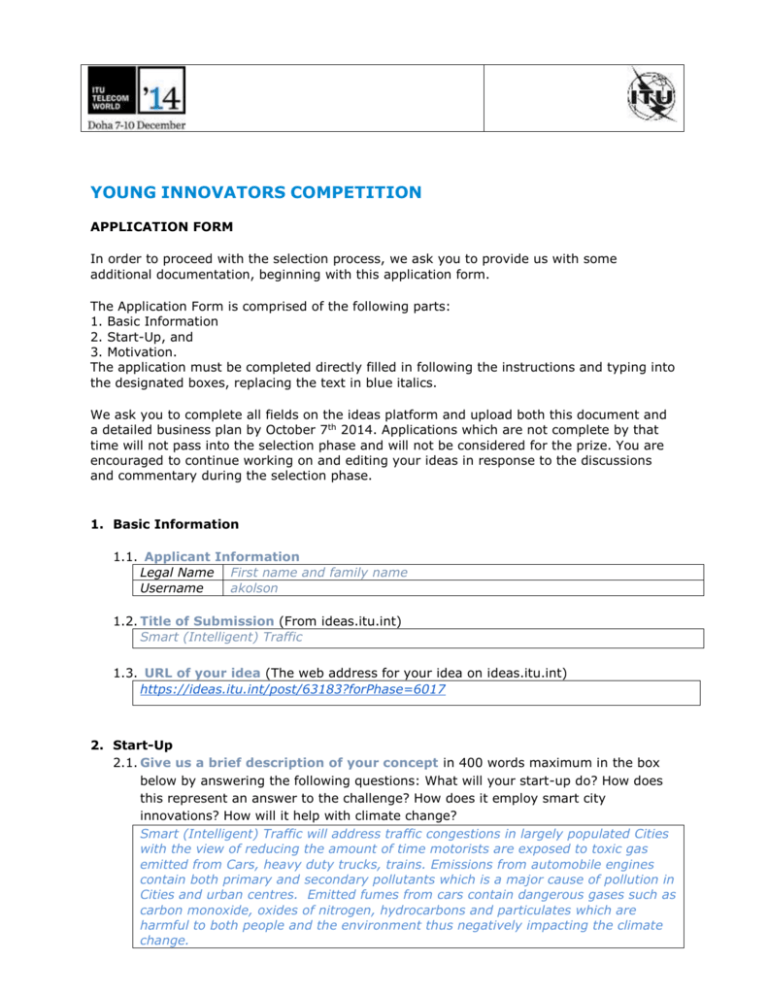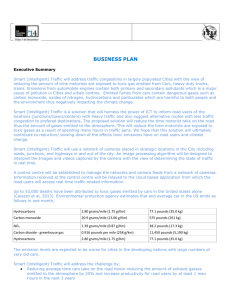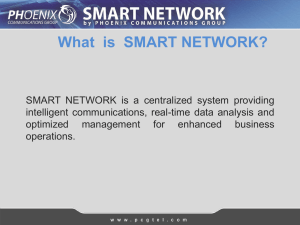application form
advertisement

YOUNG INNOVATORS COMPETITION APPLICATION FORM In order to proceed with the selection process, we ask you to provide us with some additional documentation, beginning with this application form. The Application Form is comprised of the following parts: 1. Basic Information 2. Start-Up, and 3. Motivation. The application must be completed directly filled in following the instructions and typing into the designated boxes, replacing the text in blue italics. We ask you to complete all fields on the ideas platform and upload both this document and a detailed business plan by October 7th 2014. Applications which are not complete by that time will not pass into the selection phase and will not be considered for the prize. You are encouraged to continue working on and editing your ideas in response to the discussions and commentary during the selection phase. 1. Basic Information 1.1. Applicant Information Legal Name First name and family name Username akolson 1.2. Title of Submission (From ideas.itu.int) Smart (Intelligent) Traffic 1.3. URL of your idea (The web address for your idea on ideas.itu.int) https://ideas.itu.int/post/63183?forPhase=6017 2. Start-Up 2.1. Give us a brief description of your concept in 400 words maximum in the box below by answering the following questions: What will your start-up do? How does this represent an answer to the challenge? How does it employ smart city innovations? How will it help with climate change? Smart (Intelligent) Traffic will address traffic congestions in largely populated Cities with the view of reducing the amount of time motorists are exposed to toxic gas emitted from Cars, heavy duty trucks, trains. Emissions from automobile engines contain both primary and secondary pollutants which is a major cause of pollution in Cities and urban centres. Emitted fumes from cars contain dangerous gases such as carbon monoxide, oxides of nitrogen, hydrocarbons and particulates which are harmful to both people and the environment thus negatively impacting the climate change. Smart (Intelligent) Traffic is a solution that will harness the power of ICT to inform road users of the locations (junctions/towns/centers) with heavy traffic and also suggest alternative routes with less traffic congestion to preferred destinations. The proposed solution will reduce the time motorist take on the road thus the amount of gases emitted to the atmosphere. This will reduce the time motorists are exposed to toxic gases as a result of spending many hours in traffic jams. We hope that this solution will ultimately contribute to reduction/ slowing down of the effects toxic emissions have on road users and climate change. Smart (Intelligent) Traffic will use a network of cameras placed in strategic locations in the City including roads, junctions, and highways in and out of the city. An image processing algorithm will be designed to interpret the Images and videos captured by the camera with the view of determining the state of traffic in real time. A control center will be established to manage the networks and camera feeds from a network of cameras. Information received at the control center will be relayed to the cloud based application from which the road users will access real time traffic related information. 2.2. Tell us more about the Innovation in 200 words maximum in the box below by answering the following questions: How is your solution different from other existing solutions that address the Challenge? What is the novelty? Smart (Intelligent) Traffic is a solution that will harness the power of ICT to inform road users of the locations (junctions/towns/centers) with heavy traffic and also suggest alternative routes with less traffic congestion to preferred destinations. Smart (Intelligent) Traffic will enable motorists to access information on traffic using their phones. Images from cameras will be processed from the control center and relayed to the cloud based portal from which users are able to access the state of traffic in real time. Users will have access to information on state of traffic on specific routes and locations on cities. The proposed solution will reduce the time motorist take on the road thus reduction in the amount of gases emitted to the atmosphere and exposure to toxic gases. There are few Cities and towns in developing countries that use smart intelligent traffic to manage traffic. Where Systems are in place, they are used to monitor defaulting road users, monitor security and in some cases used by city management to plan for future road network expansion. The novelty in Smart (Intelligent) Traffic is relaying of data to the cloud portal and integration of mobile phones to enable users to access information city traffic. 2.3. Tell us more about the Social Impact in 200 words maximum by answering the following questions: What has been and is the projected impact (over the next 1-3 years) of your initiative? Outline the quality and the quantity; describe how it makes a difference! Heavy traffic Jams and air pollution has become a global challenge. Uganda like other large cities in the developing nations are struggling to find new ways to manage traffic and reduce toxic gases emitted to the atmosphere by cars and industries (BBC.com, Sept 2012). Up to 53,000 deaths have been attributed to toxic gases emitted by cars in the United states alone (Caiazzo et al, 2013). Environmental protection agency estimates that and average car in the US emits as follows in one month; Hydrocarbons 2.80 grams/mile (1.75 g/Km) 77.1 pounds (35.0 kg) Carbon monoxide 20.9 grams/mile (13.06 g/Km) 575 pounds (261 kg) NOx 1.39 grams/mile (0.87 g/Km) 38.2 pounds (17.3 kg) Carbon dioxide - greenhouse gas 0.916 pounds per mile (258 g/km) 11,450 pounds (5,190 kg) Hydrocarbons 2.80 grams/mile (1.75 g/Km) 77.1 pounds (35.0 kg) Emissions are expected to be worse for cities in developing nations with more old cars. Smart (Intelligent) Traffic will address the challenge by; ● Reducing average time cars take on the road hence reducing the amount of exhaust gasses emitted to the atmosphere and improved productivity for road users ● Reducing the time which motorists are exposed to toxic gases while in traffic jams 2.4. Tell us more about the Implementation in 200 words maximum by answering the following questions: How do you plan to go about developing your start-up? What are some of the milestones for your future development? What is the potential for growth? We hope to deliver our initiative by identifying cities to begin with. The choice of cities to work with when developing the project will be based on convenience and flexibility of the concerned authorities. Initial consultations with Key strategic actors: This will give the stakeholders an opportunity to refine the initial idea. Stakeholders to be consulted include the city authorities of selected cities. Systems requirements will be determined during this stage.The team will also seek for permission to use the existing infrastructure including CCTV cameras, Network and data centers among other things. System analysis and design: The team will design the system based on requirements collected from key stakeholders System development: This will involve the team developing applications, databases, interfaces. System testing: This will involve the team testing the application at different levels to ensure conformity to system requirements. Milestones: If successfully implemented, we see the idea spreading across all major cities in developing countries embracing the system. We plan to approach Kampala Capital City Authority to work with us in developing this concept. Monitoring and Evaluation: The idea project will undergo an independent monitoring and evaluation to ensure objectives and timelines of the project are attained as planned. 2.5. Tell us more about the Feasibility in 200 words maximum by answering the following questions: How do you envision success for your initiative? What barriers might hinder it? How do you plan to overcome them? What momentum does your initiative have? What phase is it at and how will it advance? Smart (Intelligent) Traffic has great potential for success especially in developing countries like Uganda that is still grappling with challenges associated with traffic management. The solution will also be of interest to Governments that are passionate about reducing green gas emission to the atmosphere. Illnesses and deaths associated with exhaust gas emissions will be reduced thus the need for every city to adopt the technology. Being a new concept, some cities and governments may not be willing to take up the concept. Some authorities may not be willing give third parties access to their infrastructures and systems including data centers, Network and cameras. We plan to involve key stakeholders in the initial planning and development of the idea. This will help them to improve the idea and buy in to the project. We plan to propose co-ownership to city projects so that we the implementers are looked as partners instead of looking at them as third parties. 3. Motivation 3.1. Tell us more about yourself and the Young Innovators Competition in 100 words maximum by answering the following questions: Why are you applying to this competition? How will winning the ITU Telecom Young Innovators Competition help you deliver the initiative? Which benefits are crucial for you at this stage? Why should we choose you? My passion and desire to see a better world is my inspiration for participating in this competition. I intend to use my expertise to design ICT Solutions to solve development challenges like Climate change, thus Smart (Intelligent) Traffic. Winning will provide me a platform to network, be mentored by some of the best, and open possible funding opportunities. I believe mentorship and networks with some of key players in the sector will push the idea forward. I am young and self-motivated; choosing me will open great opportunities for me to contribute to wider audiences. 3.2. Tell us more about yourself in 100 words maximum in the box below, by answering the following questions: What makes you a social entrepreneur? What are your most important skills, capabilities, and personality traits? How did you come up with the idea? Why is it important for you? I am a software developer and designer with a passion and enthusiasm for quality in whatever I do. I always strive for the best and am a good learner as well. This has enabled me to develop some simple but effective tools like the document tracker. In Kampala (Uganda), we tend to experience heavy traffic especially during rush hours. As a result, there is emission of toxic gases that are detrimental to both individuals and the environment. As a developer, this is important for me because I love to come up with solutions that address real life challenges.







